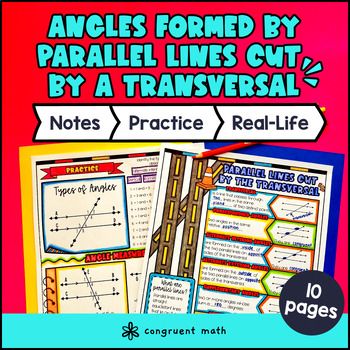Want more ideas and freebies?
Get my free resource library with digital & print activities—plus tips over email.
Join for free resources →
$4.25
Ever wondered how to teach angles formed by parallel lines cut by a transversal in an engaging way to your 8th-grade students?
In this lesson plan, students will learn about parallel lines cut by a transversal and their real-life applications. Angle pairs include corresponding angle, alternate interior angles, alternate exterior angles, vertical angles, consecutive interior angles, and supplementary angles.
Through artistic, interactive guided notes, check for understanding, practice coloring worksheet, and a maze worksheet, students will gain a comprehensive understanding of angle relationships.
The lesson ends with a real-life example that explores how understanding angle relationships can be applied in solving real-world problems.

$4.25
After this lesson, students will be able to:
Before this lesson, students should be familiar with:
As a hook, ask students why understanding angles formed by parallel lines cut by a transversal is important in everyday life. You can refer to the real-life application provided in the resource for inspiration.
Use the first page of the guided notes to introduce the concept of parallel lines, transversals, corresponding angles, alternate interior angles and alternate exterior angle, vertical angles, consecutive interior angles, and supplementary angles. Walk through the definition of corresponding angles and highlight key examples to illustrate this concept. Emphasize how angles types that are congruent when the lines are parallel and angle types that are supplementary.
Refer to the FAQ section below for a walk-through on corresponding angles and strategies on how to address common student questions regarding this angle relationship.
For the second page of the guided notes to provide visual examples to help students understand how to identify and work with them in the context of parallel lines and transversals. Students practice setting up equations to find the missing angle or missing variables.
Based on the responses from students during the introduction, reteach any concepts that students need additional support with. If there is a wide range of proficiency levels in the class, consider pulling out students for reteaching while allowing more advanced students to start working on the practice exercises in the resource.
Have students practice identifying and solving for angles formed by parallel lines cut by a transversal using the practice worksheet like the maze activity (pg. 3) provided in the resource. Walk around to answer student questions.
Fast finishers can dive into the color by number activity (pg. 4) for extra practice. You can assign it as homework for the remainder of the class.
Bring the class back together, and introduce the concept of using angles formed by parallel lines cut by a transversal in real-life scenarios. Engage students in discussing how understanding these angle relationships can be applied in architecture, interior design, and engineering to ensure symmetry and precision in structures. Refer to the FAQ for more ideas on how to teach it!
A fun, no-prep way to practice Parallel Lines Cut By a Transversal is Doodle Math — they’re a fresh take on color by number or color by code. It includes multiple levels levels of practice, perfect for a review day or sub plan.
Here is an activity to try:
If you’re looking for digital practice for Parallel Lines Cut By a Transversal, try my Pixel Art activities in Google Sheets. Every answer is automatically checked, and correct answers unlock parts of a mystery picture. It’s incredibly fun, and a powerful tool for differentiation.
Here’s an activity to explore:
Corresponding angles are pairs of angles that are on the same side of the transversal and in the same position relative to the parallel lines.
Alternate interior angles are angles that lie inside the parallel lines and on opposite sides of the transversal.
Vertical angles are pairs of angles that are opposite each other when two lines intersect. In the case of parallel lines cut by a transversal, vertical angles can be found where the lines intersect.
Consecutive interior angles are pairs of angles that are on the same side of the transversal and inside the parallel lines.
Alternate exterior angles are pairs of angles that are outside the parallel lines and on opposite sides of the transversal.
Supplementary angles are angles that add up to 180 degrees.
Understanding angles formed by parallel lines cut by a transversal helps in solving geometric problems involving angles and lines.
Get my free resource library with digital & print activities—plus tips over email.
Join for free resources →